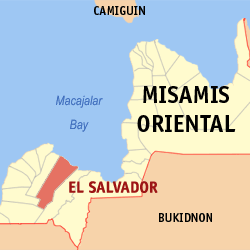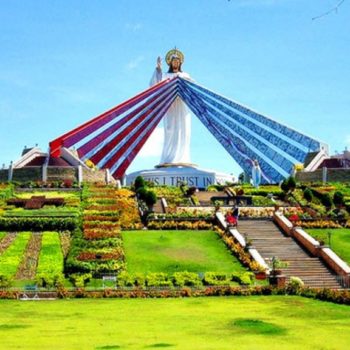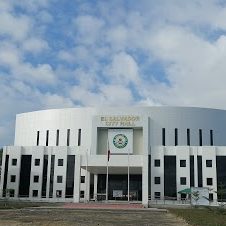ABOUT EL SALVADOR
El Salvador City is a 6th class component city in the province of Misamis Oriental, Philippines. According to the 2015 census, it has a population of 50, 204 people.
The City serves as a pilgrimage site for divine mercy devotees, that is why it is also called the City of Saviour, City of Mercy, and the Divine Mercy City of the Philippines.
HISTORY
El Salvador is a City in the province of Misamis Oriental in Mindanao Island, Southern part of the Philippines. The city serves as a pilgrimage site for the Divine Mercy devotees that is why it is now famous as “The City of Mercy”.
Legend has it that a long time ago during the Spanish time the City, then a municipality, was named Tagnipa because of the abundance of nipa plants in the locality. That once upon a time, hunger occurred in the entire province and it was only Tagnipa that had continuous yields of corn and vegetables which have served not only the Tagnipan-ons (the locals) but including those in the neighboring areas. Because of such event, that the people were saved from hunger, the populace agreed to change the name “TAGNIPA” to “EL SALVADOR”, a Spanish term meaning, “THE SAVIOUR”.
El Salvador was a former barrio of the former Municipality of Cagayan de Oro. On June 15, 1948, Republic Act 268 created El Salvador as a municipality and officially functioned as such in August 2, 1948. Almost six decades after, in June 27, 2007, through the initiative of former Congressman Augusto H. Baculio, RA 9435, otherwise known as the Charter of the City of El Salvador, converted the municipality into a component city of the Province of Misamis Oriental. It comprises 15 barangays of which 8 are urban/urbanizing and 7 rural barangays. The
fight on the legal aspect of becoming a city was extended and very challenging. After almost 4 years of heartrending court battle, the finality of the cityhood was entered in the book of judgment on February 15, 2011, thus granting El Salvador the status as a City.
Like most of the 23 municipalities in Misamis Oriental, El Salvador City is along the shores of Macajalar Bay, Northwest of Mindanao. It is bounded in the North by Macajalar Bay, East by the Municipality of Opol, in the South by the Municipality of Manticao and in the West by the Municipality of Alubijid.



GEOGRAPHY
El Salvador is located in the Province of Misamis Oriental in Northern Mindanao (Region X). It is bordered by the Municipality of Alubijid to the west, Opol to the east and Manticao and Naawan to the south. On the north, lies Macajalar Bay in the Bohol Sea.
BARANGAYS
Administratively, El Salvador is subdivided into 15 barangays. One forms the center of the city poblacion whereas the other 14 are in the outlying areas. Some of them are even several kilometers away from the center of the city.
- Amoros
- Bolisong
- Cogon
- Himaya
- Hinigdaan
- Kalabaylabay
- Molugan
- Pedro S. Baculio (Bolo-Bolo)
- Poblacion
- Quibonbon
- Sambulawan
- San Francisco de Asis (Calongonan)
- Sinaloc
- Taytay
- Ulaliman
ATTRACTIONS
- Divine Mercy Shrine (Misamis Oriental), located in the Divine Mercy Hills, PSB-Ulaliman which is overlooking Macajalar Bay. The shrine has a 50-foot statue of the Divine Mercy Christ, the biggest in Asia. It serves as a pilgrimage site for the Divine Mercy devotees. As a pilgrimage and sacred site, visitors are not allowed to wear shorts and other revealing clothing. Those who do so will be forced to cover themselves with a blue cloth provided by the shrine administrators.
- Burias Island, located just a few kilometers off the coast of Molugan or about 3 km west of the town of Opol.
- El Salvador Night Café and Market, is set up on Friday night at Barangay Poblacion. Tagnipa-ons and visitors gather to have barbecue, enjoy the live band music, beer, and also the great bargains from the nearby Night Market
- Our Lady of Snows Parish Church, newly constructed church located within the city.
- Abaga & Sikiop Falls, Located in barangay San Francisco de Asis.
- Tag-ilas Falls, Located in barangay Hinigdaan.
- Tuburan Spring, Located in barangay Poblacion .
- House of Pasalubong, Located in Zone 2, Barangay Poblacion
CULTURE
The culture of El Salvador is a mixture of different cultures influenced by the people from different places. It has a distict influence of bol-anons who migrated to El Salvador during the early 1900’s Foreign cultures like the Chinese traders, Spaniards and americans are also evident in the modern tagnipan-on culture. The Tagnipan-ons has a strong sense of family and can easily recall their relatives to the extent of knowing their great forefathers. During the difficult times the family is their source of strength and their solace. It is common in the family to allow their children to stay with their parents even if they are already adults as long as they are single. They are also a strong believer of Christ and is generally religious in fact more than 85% of us are Roman Catholics.
Until now even with the many modem influences Tagnipan-ons are still practicing “Pakikisama and Utang na Loob” something that may not be common to other cultures. Pakikisama means “getting along” it is commonly practiced by allowing some improprieties or indescretions to maintain peace in the family and even in the community. Another is that we are also very hospitable people, this is very evident during fiesta and othe celebrations where tagnipan-ons will open their houses for anybody who wish to pertake with the feast & celebration.
Tagnipan-ons are also very friendly and will easily get along with anybody. There is also one distinct characteristic with these people, when they talk they are “High pitch” and will usually confused visitors. Many would think that hese people are angry but in reality they are not and it still the way they speak.
